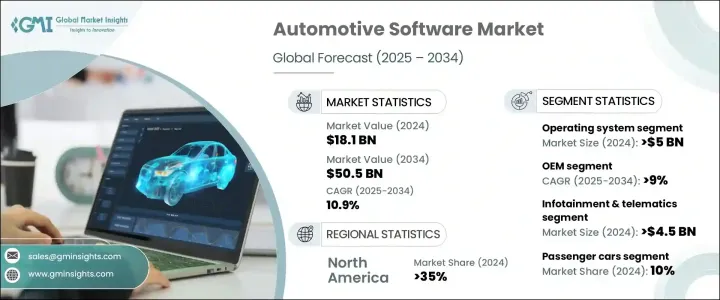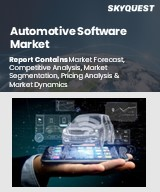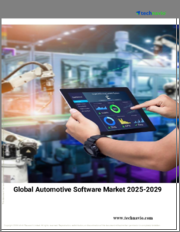
|
시장보고서
상품코드
1684831
자동차 소프트웨어 시장 기회, 성장 촉진요인, 산업 동향 분석, 예측(2025-2034년)Automotive Software Market Opportunity, Growth Drivers, Industry Trend Analysis, and Forecast 2025 - 2034 |
||||||
2024년에 181억 달러로 평가된 세계의 자동차 소프트웨어 시장은 2025년부터 2034년에 걸쳐 CAGR 10.9%를 나타낼 것으로 예측됩니다.
커넥티드카에 대한 수요 증가와 자율주행 중시 증가가 이 시장 확대의 주요 촉진요인이 되고 있습니다. 레벨 3 이상의 자율주행차의 채용이 급증할 것으로 예상되어 연결성, 데이터 처리, 자율주행 기능을 촉진하는 고급 소프트웨어 솔루션에 대한 강한 수요가 탄생하고 있습니다. 인포테인먼트 및 파워트레인 관리 등 소프트웨어 용도의 통합이 진행되고 있는 것도 시장의 성장을 더욱 추진하고 있습니다.

전동화와 커넥티비티가 자동차 업계를 재구성함에 따라 강력한 소프트웨어 솔루션에 대한 수요가 계속 증가하고 있습니다. 자동차는 R&D에 적극적으로 투자하고 차량 소프트웨어의 기능을 강화함으로써 신기술의 원활한 통합을 가능하게 하고 차량 전체의 성능을 향상시키고 있습니다. 세계 소프트웨어 허브의 확대도 소프트웨어 정의 자동차와 자율주행 기술에 대한 주목이 높아지고 있음을 뒷받침하고 있습니다. 자동차 제조업체는 안전, 효율성, 사용자 경험을 향상시키기 위해 소프트웨어 중심의 혁신을 우선시하고 경쟁 구도가 진화하고 있습니다.
| 시장 범위 | |
|---|---|
| 시작 연도 | 2024년 |
| 예측 연도 | 2025-2034년 |
| 시작 금액 | 181억 달러 |
| 예측 금액 | 505억 달러 |
| CAGR | 10.9% |
자동차 소프트웨어 시장은 운영 체제, 미들웨어, 용도 소프트웨어로 분류됩니다. 운영 체제는 2024년 50억 달러 이상으로 평가되었으며, 고급 차량 기능을 지원하기 위해 용도과 하드웨어를 통합하는 데 중요한 역할을 하고 있습니다. 미들웨어는 다양한 소프트웨어 구성 요소 간의 원활한 통신을 가능하게 하므로 채택이 증가하고 있습니다. 인포테인먼트, 네비게이션, 커넥티비티에 대한 소비자의 선호도가 높아지면서 사용자 경험을 향상시키는 용도 소프트웨어 수요를 뒷받침하고 있습니다. 자동차 제조업체는 커넥티드카 사용자의 진화 기대에 부응하기 위해 혁신적인 용도을 지속적으로 개발하고 있습니다.
최종 용도에 따라 시장은 OEM 시장과 애프터마켓 시장으로 나뉩니다. OEM은 자동차 제조업체들이 정교한 소프트웨어 솔루션 개발에 많은 투자를 하고 있기 때문에 2025년부터 2034년까지 연평균 복합 성장률(CAGR) 9% 이상을 나타낼 것으로 예상되고 있습니다. 엄격한 규제 요건은 자동차 제조업체에게 자동차 성능과 안전성을 높이는 고급 소프트웨어 통합을 촉구합니다. 또한 소비자가 고급 기능으로 자동차를 업그레이드하고 기능과 사용자 정의를 최적화하려고 애프터마켓 소프트웨어 솔루션이 인기를 얻고 있습니다.
시장은 용도별로 안전 시스템, 파워트레인 & 섀시, 인포테인먼트 & 텔레매틱스, 바디 컨트롤 & 컴포트 등으로 구분됩니다. 인포테인먼트 & 텔레매틱스는 시장을 선도하고 2024년에는 45억 달러 이상을 창출했습니다. 실시간 정보, 엔터테인먼트 및 커넥티비티에 대한 수요가 증가함에 따라 첨단 인포테인먼트 시스템의 개발이 촉진되고 있습니다. 안전 기능 강화의 추진으로 규제 준수 및 차량 보안 향상을 목적으로 한 소프트웨어 솔루션에 대한 투자가 가속화되고 있습니다. 파워트레인과 섀시의 관리 소프트웨어도 제조업체가 연비 효율과 배출 가스를 줄이기 위해 노력하는 동안 큰 성장을 이루고 있습니다.
시장은 차종별로 승용차와 상용차로 구분됩니다. 승용차는 커넥티비티, 안전성, 엔터테인먼트를 위한 임베디드 소프트웨어 솔루션의 채용이 확대되고 있으며, 2024년 시장 점유율의 약 10%를 차지했습니다. 첨단 자동차 소프트웨어는 승용차에 탑재가 진행되고 있어 무선 업데이트, 자율주행 기능, 개인화된 사용자 체험을 가능하게 하고 있습니다. 상용차는 기술이 고도화됨에 따라 성능, 안전성 및 규정 준수를 최적화하는 소프트웨어 요구가 커지고 있습니다.
북미는 자동차 소프트웨어 시장을 선도하고 2024년 세계 점유율의 35% 이상을 차지했으며 미국이 그 최전선에 있습니다. 상용차 분야에서는 저연비차로의 시프트가 진행되고 있어, 제조업체 각사는 선진적인 소프트웨어 솔루션을 통해 엔진 성능의 향상을 도모하고 있습니다. 자동차 제조업체는 안전성, 효율성, 컴플라이언스를 향상시키는 기술에 투자하고 있으며 시장은 확대될 것으로 보입니다. ADAS(선진운전지원시스템)의 채용은 불가결해지고 있어 자동차의 안전성을 높이면서 규제 준수를 확실하게 하고 있습니다. 기술적으로 첨단 자동차에 대한 수요가 증가함에 따라 자동차 분야에서 스마트 소프트웨어 솔루션의 중요성이 높아지고 있습니다.
목차
제1장 조사 방법과 조사 범위
- 조사 디자인
- 조사 접근
- 데이터 수집 방법
- 기본 추정과 계산
- 기준연도의 산출
- 시장추계의 주요 동향
- 예측 모델
- 1차 조사와 검증
- 1차 정보
- 데이터 마이닝 소스
- 시장 범위와 정의
제2장 주요 요약
제3장 업계 인사이트
- 생태계 분석
- 공급자의 상황
- 기술 통합업체
- 플랫폼 제공업체
- 서비스 제공업체
- 최종 사용자
- 이익률 분석
- 기술과 혁신의 전망
- 특허 분석
- 규제 상황
- 커넥티드카의 차량 규모(2021-2024년)
- ADAS와 인포테인먼트 소프트웨어의 비교 분석
- 영향요인
- 성장 촉진요인
- 커넥티드 카 기술의 채용 확대
- 차재 인포테인먼트 시스템에 대한 소비자 기호의 고조
- ADAS(첨단 운전자 지원 시스템)의 도입 가속
- 자동차의 안전성 컴플라이언스와 규제 준수의 중시 고조
- 자동차 소프트웨어에 있어서의 인공지능(AI) 통합 확대
- 업계의 잠재적 위험 및 과제
- 멀티 벤더 플랫폼을 위한 상호 운용 가능한 소프트웨어 개발의 복잡성
- 커넥티드카와 관련된 사이버 보안 위협
- 성장 촉진요인
- 성장 가능성 분석
- Porter's Five Forces 분석
- PESTEL 분석
제4장 경쟁 구도
- 서론
- 기업 점유율 분석
- 경쟁 포지셔닝 매트릭스
- 전략 전망 매트릭스
제5장 시장 추계·예측 : 제공별(2021-2034년)
- 주요 동향
- 운영 시스템
- 미들웨어
- 애플리케이션 소프트웨어
제6장 시장 추계·예측 : 차량별(2021-2034년)
- 주요 동향
- 승용차
- 해치백
- 세단
- SUV
- 상용차
- 소형 상용차(LCV)
- 대형 상용차(HCV)
제7장 시장 추계·예측 : 추진별(2021-2034년)
- 주요 동향
- ICE
- 전기자동차
제8장 시장 추계·예측 : 용도별(2021-2034년)
- 주요 동향
- 안전 시스템
- 인포테인먼트 및 텔레매틱스
- 파워트레인 및 섀시
- 바디 컨트롤 및 컴포트
- 기타
제9장 시장 추계·예측 : 최종 용도별(2021-2034년)
- 주요 동향
- OEM
- 애프터마켓
제10장 시장 추계·예측 : 지역별(2021-2034년)
- 주요 동향
- 북미
- 미국
- 캐나다
- 유럽
- 영국
- 독일
- 프랑스
- 이탈리아
- 스페인
- 러시아
- 북유럽
- 아시아태평양
- 중국
- 인도
- 일본
- 호주
- 한국
- 동남아시아
- 라틴아메리카
- 브라질
- 멕시코
- 아르헨티나
- 중동 및 아프리카
- UAE
- 남아프리카
- 사우디아라비아
제11장 기업 프로파일
- Aptiv
- BlackBerry Limited(QNX)
- Continental
- Denso
- Elektrobit Automotive
- Harman International
- Intel Corporation
- KPIT
- Luxoft
- Magna
- NVIDIA
- NXP Semiconductors
- Panasonic
- Renesas Electronics
- Robert Bosch
- Siemens
- Tata Elxsi
- Vector Informatik
- Visteon
- Wind River Systems
The Global Automotive Software Market, valued at USD 18.1 billion in 2024, is projected to grow at a CAGR of 10.9% from 2025 to 2034. The rising demand for connected vehicles and the growing emphasis on autonomous driving are key drivers of this expansion. The adoption of Level 3 and higher autonomous vehicles is anticipated to surge, creating a strong demand for advanced software solutions that facilitate connectivity, data processing, and autonomous functionality. The increasing integration of software applications, such as infotainment and powertrain management, further fuels market growth.

As electrification and connectivity reshape the automotive landscape, the demand for robust software solutions continues to escalate. Automotive companies are actively investing in research and development to enhance vehicle software capabilities, enabling seamless integration of new technologies and improving overall vehicle performance. The expansion of global software hubs also underscores the growing focus on software-defined vehicles and automated driving technology. The competitive landscape is evolving as automakers prioritize software-driven innovations to enhance safety, efficiency, and user experience.
| Market Scope | |
|---|---|
| Start Year | 2024 |
| Forecast Year | 2025-2034 |
| Start Value | $18.1 Billion |
| Forecast Value | $50.5 Billion |
| CAGR | 10.9% |
The automotive software market is categorized by offering into operating systems, middleware, and application software. Operating systems, valued at over USD 5 billion in 2024, play a crucial role in integrating applications with hardware to support advanced vehicle functionalities. Middleware adoption is increasing as it enables seamless communication between various software components, essential for modern interconnected vehicles. The rising consumer preference for infotainment, navigation, and connectivity drives demand for application software that enhances user experience. Automakers are continuously developing innovative applications to meet the evolving expectations of connected vehicle users.
Based on end use, the market is divided into OEM and aftermarket segments. OEMs are expected to grow at a CAGR of over 9% from 2025 to 2034 as manufacturers invest heavily in developing sophisticated software solutions. Stringent regulatory requirements are pushing automakers to integrate advanced software that enhances vehicle performance and safety. Additionally, aftermarket software solutions are gaining traction as consumers seek to upgrade their vehicles with advanced features, optimizing functionality and customization.
By application, the market is segmented into safety systems, powertrain & chassis, infotainment & telematics, body control & comfort, and others. Infotainment & telematics led the market, generating over USD 4.5 billion in 2024. Increasing demand for real-time information, entertainment, and connectivity is driving the development of advanced infotainment systems. The push for enhanced safety features is accelerating investment in software solutions designed to meet regulatory compliance and improve vehicle security. Powertrain and chassis management software is also experiencing significant growth as manufacturers strive for fuel efficiency and emissions reduction
The market is segmented by vehicle type into passenger cars and commercial vehicles. Passenger cars accounted for approximately 10% of the market share in 2024, with the growing adoption of embedded software solutions for connectivity, safety, and entertainment. Advanced automotive software is increasingly integrated into passenger vehicles, enabling over-the-air updates, autonomous features, and personalized user experiences. In commercial vehicles, the need for software that optimizes performance, safety, and regulatory compliance is increasing as technology becomes more advanced.
North America led the automotive software market, holding over 35% of the global share in 2024, with the United States at the forefront. The commercial sector is experiencing a shift toward fuel-efficient vehicles, prompting manufacturers to enhance engine performance through advanced software solutions. The market is set to expand as automakers invest in technologies that improve safety, efficiency, and compliance. The adoption of advanced driver assistance systems is becoming essential, ensuring regulatory compliance while enhancing vehicle safety. The rising demand for technologically advanced vehicles underscores the growing importance of smart software solutions in the automotive sector.
Table of Contents
Chapter 1 Methodology & Scope
- 1.1 Research design
- 1.1.1 Research approach
- 1.1.2 Data collection methods
- 1.2 Base estimates & calculations
- 1.2.1 Base year calculation
- 1.2.2 Key trends for market estimation
- 1.3 Forecast model
- 1.4 Primary research and validation
- 1.4.1 Primary sources
- 1.4.2 Data mining sources
- 1.5 Market scope & definition
Chapter 2 Executive Summary
- 2.1 Industry 3600 synopsis, 2021 - 2034
Chapter 3 Industry Insights
- 3.1 Industry ecosystem analysis
- 3.2 Supplier landscape
- 3.2.1 Technology integrators
- 3.2.2 Platform providers
- 3.2.3 Service providers
- 3.2.4 End users
- 3.3 Profit margin analysis
- 3.4 Technology & innovation landscape
- 3.5 Patent analysis
- 3.6 Regulatory landscape
- 3.7 Connected car fleet size, 2021-2024
- 3.8 Comparative analysis of ADAS vs. infotainment software
- 3.9 Impact forces
- 3.9.1 Growth drivers
- 3.9.1.1 Increasing adoption of connected car technologies
- 3.9.1.2 Rising consumer preference for in-vehicle infotainment systems
- 3.9.1.3 Accelerated deployment of Advanced Driver-Assistance Systems (ADAS)
- 3.9.1.4 Growing emphasis on vehicle safety compliance and regulatory adherence
- 3.9.1.5 Expanding integration of Artificial Intelligence (AI) in automotive software
- 3.9.2 Industry pitfalls & challenges
- 3.9.2.1 Complexity in developing interoperable software for multi-vendor platforms
- 3.9.2.2 Cybersecurity threats associated with connected vehicles
- 3.9.1 Growth drivers
- 3.10 Growth potential analysis
- 3.11 Porter’s analysis
- 3.12 PESTEL analysis
Chapter 4 Competitive Landscape, 2024
- 4.1 Introduction
- 4.2 Company market share analysis
- 4.3 Competitive positioning matrix
- 4.4 Strategic outlook matrix
Chapter 5 Market Estimates & Forecast, By Offering, 2021 - 2034 ($Bn, Units)
- 5.1 Key trends
- 5.2 Operating system
- 5.3 Middleware
- 5.4 Application software
Chapter 6 Market Estimates & Forecast, By Vehicle, 2021 - 2034 ($Bn)
- 6.1 Key trends
- 6.2 Passenger cars
- 6.2.1 Hatchback
- 6.2.2 Sedan
- 6.2.3 SUV
- 6.3 Commercial vehicles
- 6.3.1 Light Commercial Vehicles (LCV)
- 6.3.2 Heavy Commercial Vehicles (HCV)
Chapter 7 Market Estimates & Forecast, By Propulsion, 2021 - 2034 ($Bn)
- 7.1 Key trends
- 7.2 ICE
- 7.3 Electric vehicle
Chapter 8 Market Estimates & Forecast, By Application, 2021 - 2034 ($Bn)
- 8.1 Key trends
- 8.2 Safety systems
- 8.3 Infotainment & telematics
- 8.4 Powertrain & chassis
- 8.5 Body control & comfort
- 8.6 Others
Chapter 9 Market Estimates & Forecast, By End Use, 2021 - 2034 ($Bn)
- 9.1 Key trends
- 9.2 OEM
- 9.3 Aftermarket
Chapter 10 Market Estimates & Forecast, By Region, 2021 - 2034 ($Bn)
- 10.1 Key trends
- 10.2 North America
- 10.2.1 U.S.
- 10.2.2 Canada
- 10.3 Europe
- 10.3.1 UK
- 10.3.2 Germany
- 10.3.3 France
- 10.3.4 Italy
- 10.3.5 Spain
- 10.3.6 Russia
- 10.3.7 Nordics
- 10.4 Asia Pacific
- 10.4.1 China
- 10.4.2 India
- 10.4.3 Japan
- 10.4.4 Australia
- 10.4.5 South Korea
- 10.4.6 Southeast Asia
- 10.5 Latin America
- 10.5.1 Brazil
- 10.5.2 Mexico
- 10.5.3 Argentina
- 10.6 MEA
- 10.6.1 UAE
- 10.6.2 South Africa
- 10.6.3 Saudi Arabia
Chapter 11 Company Profiles
- 11.1 Aptiv
- 11.2 BlackBerry Limited (QNX)
- 11.3 Continental
- 11.4 Denso
- 11.5 Elektrobit Automotive
- 11.6 Harman International
- 11.7 Intel Corporation
- 11.8 KPIT
- 11.9 Luxoft
- 11.10 Magna
- 11.11 NVIDIA
- 11.12 NXP Semiconductors
- 11.13 Panasonic
- 11.14 Renesas Electronics
- 11.15 Robert Bosch
- 11.16 Siemens
- 11.17 Tata Elxsi
- 11.18 Vector Informatik
- 11.19 Visteon
- 11.20 Wind River Systems



















